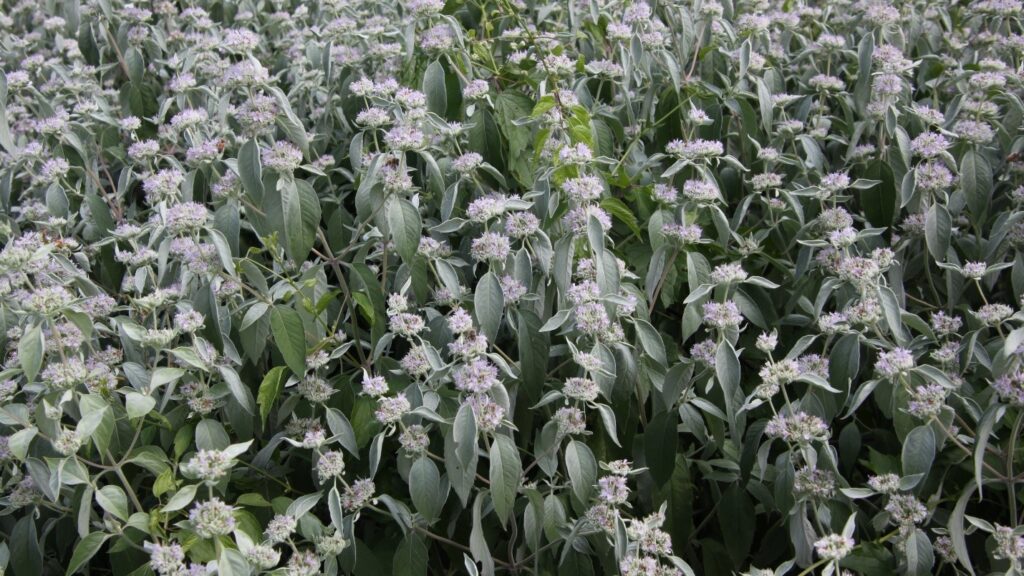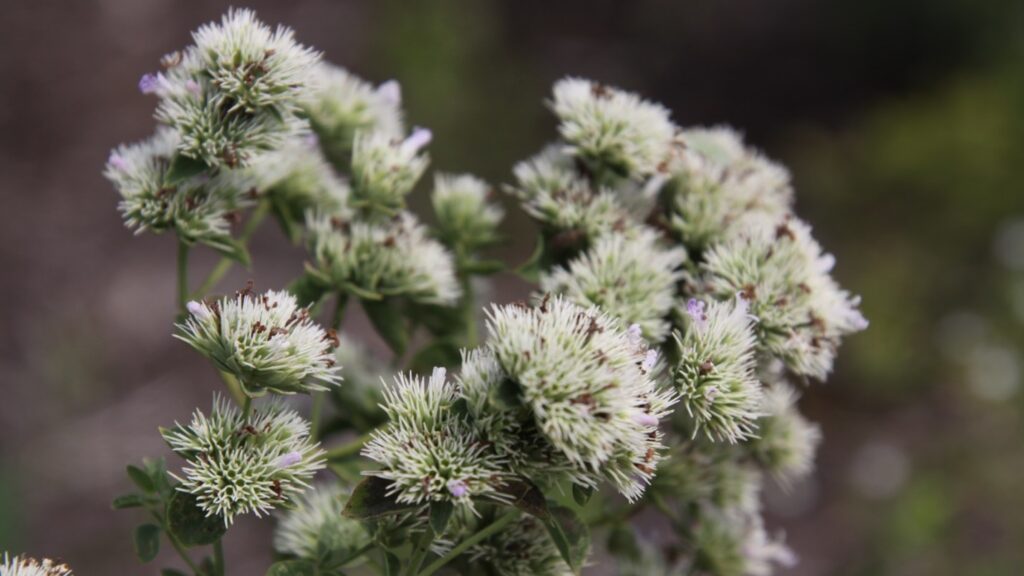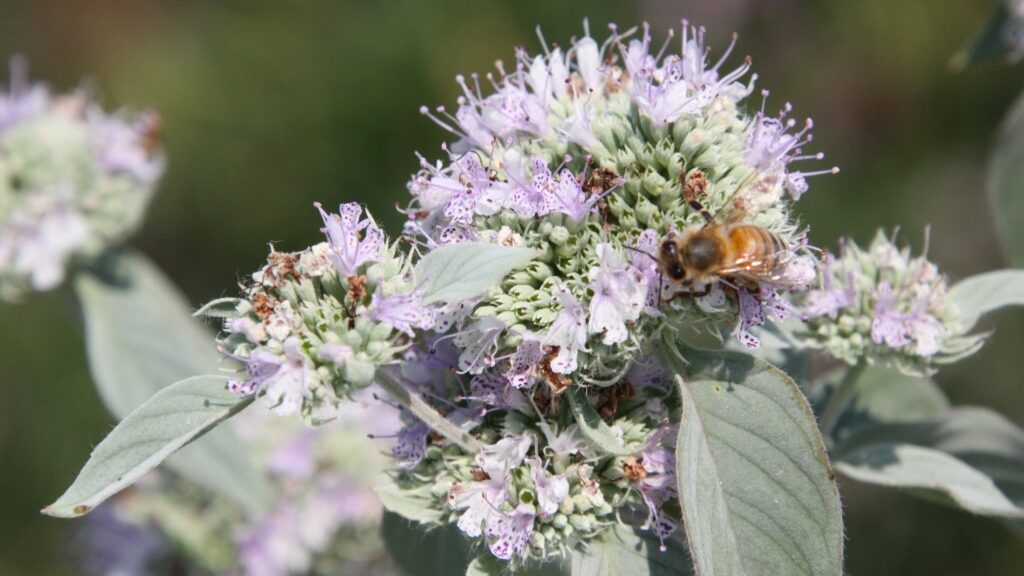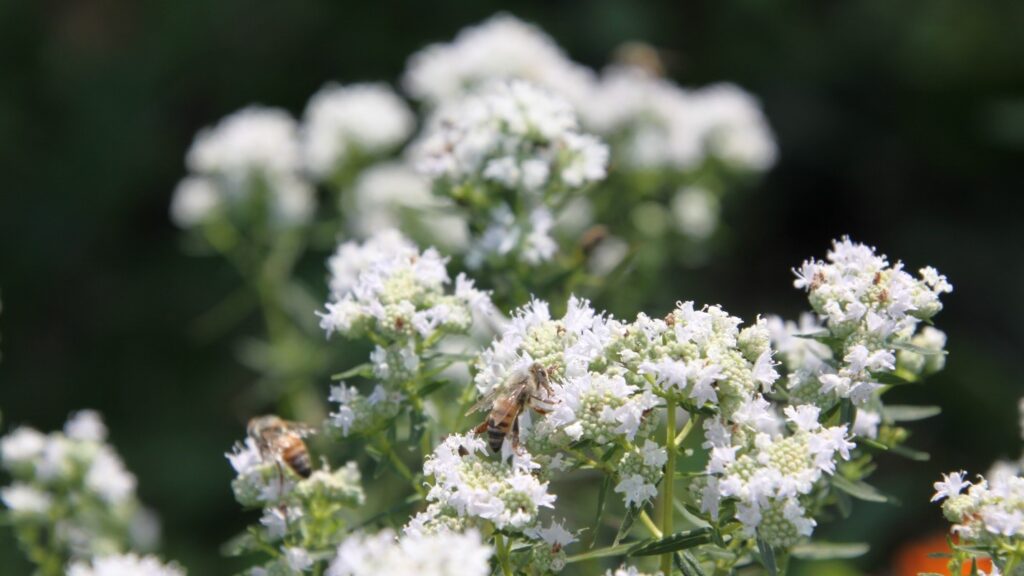
The genus Pycnanthemum, commonly known as mountain mint, includes attractive and beneficial native pollinator plants that can be found here in Pennsylvania. Mountain mints, as the name would imply, are in the Lamiaceae, or mint, family. Several species of these herbaceous perennials can be found across the eastern United States, with about eight different species occurring in Pennsylvania. There are five species planted here at the Arboretum, which have been in bloom for the last couple of months and will continue to show flowers throughout August and into September. Seed heads persist into the early autumn months and provide prolonged ornamental interest and serve as a potential food source for bird populations.
Like others in its family, Pycnanthemum is known for its minty fragrance. Similarly, some species are commonly used for flavor in cooking and tea-making and have also been used by herbalists as an insect repellent. Mountain mints are also commonly utilized in the landscape for their ornamental qualities. Species of Pycnanthemum can bloom in a variety of different colors, including white, as can be seen in narrowleaf mountain mint (pictured above), or shades of pale purple.
Additionally, mountain mints serve as an important ecological resource for different types of wildlife that may visit these plants. Pollinator visitation surrounding these plants is diverse and includes bees, butterflies, flies, and wasps. Penn State actually conducted a study a few years ago evaluating common native plant species and their attractiveness to pollinators, and mountain mint was one of the species that came out on top! This plant quite literally creates an audible buzz in the gardens in the summertime, making it a popular and lively choice for many gardeners. The strong minty fragrance that Pycnanthemum is known for also acts as a deterrent for unwanted garden guests. Voles, deer, rabbits, and groundhogs seem to dislike the minty taste and scent of the plant, which makes this an excellent choice even for more natural areas or a restoration landscape project.
Another desirable factor of mountain mint is that it is relatively easy to grow. Most species can survive in dry to wet soil, making it somewhat drought resistant. However, in general, these plants prefer full sun and consistent hydration for the best growth.

One popular species, clustered mountain mint, which also happens to be the species of mountain mint that was determined to attract the most diverse group of pollinators, is pictured above. Also sometimes known as blunt mountain mint, it can be found here at the Arboretum in the Pollinator and Bird Garden and in the Childhood’s Gate Children’s Garden. Unlike the other species, Pycnanthemum muticum has a clearer vertical structure with a pinkish-purple flower at its top and long dark green leaves along the column. Additionally, it is identifiable by the dusty, almost powdery, appearance of the leaves.

Appalachian mountain mint (pictured above) is another unique species that can be found here in the Arboretum’s Pollinator and Bird Garden. This flower is particularly attractive in a garden setting due to its unique large flowers and strong aroma. Compared to other mountain mints, Pycnanthemum flexuosum is distinct for the dense clustering of its petals. Another benefit of this species is its ability to tolerate drier and poorer soils than other mints. This makes it a good lower-maintenance choice.

The species pictured above is Pycnanthemum incanum, which is commonly known as hoary mountain mint. The common name means ‘grayish white,’ which is well earned by the silvery tint to its pale leaves and flowers. When in bloom, hoary mountain mint is even more beautiful with small purple flowers. While not as aromatic as Appalachian mountain mint, this species is frequently chosen for making herbal teas.

Another species of mountain mint is Pycnanthemum virginianum, commonly known as Virginia mountain mint (pictured above). This is one of the showier species present at the Arboretum and can be found in the Pollinator and Bird Garden, along with several other mountain mints. Its distinct white flowers make it a pleasant choice for gardeners.
One thing to note about these plants is that, depending on the species, different mints have differing levels of aggressiveness in how quickly they will spread. This can help to quickly cover an empty area of a garden you want filled, but can also cause problems if you want mountain mints in a small contained area. One way in which you can combat this spread is by pulling up rhizome roots on the plants’ edge each spring.
Mountain mints are a versatile option for beautifying a landscape and attracting important pollinators and wildlife to a garden while simultaneously serving to deter potential pests. Keep an eye out for these blooms during your summer garden stroll, and you can also try out our new Arboretum Explorer Tool on your mobile device to find the locations of mountain mints and learn more about these plants on an interactive map while visiting the gardens!

